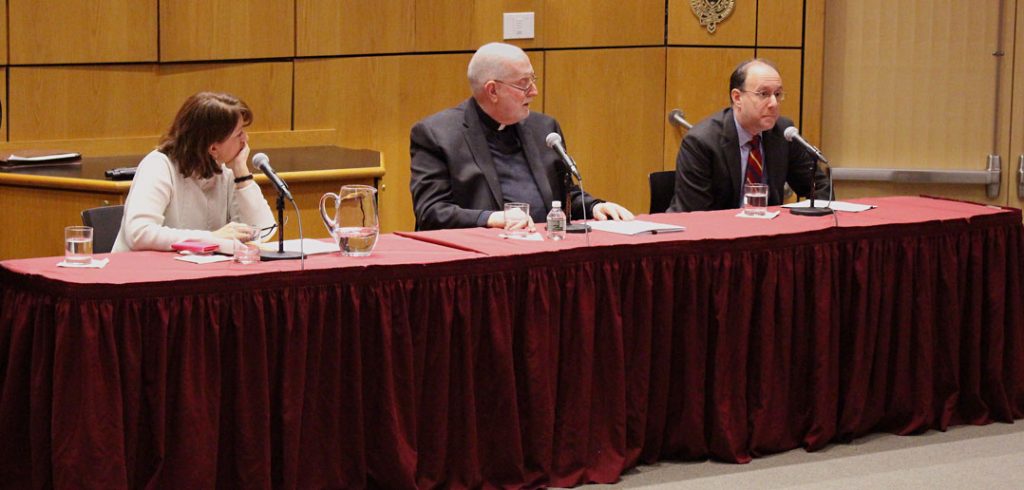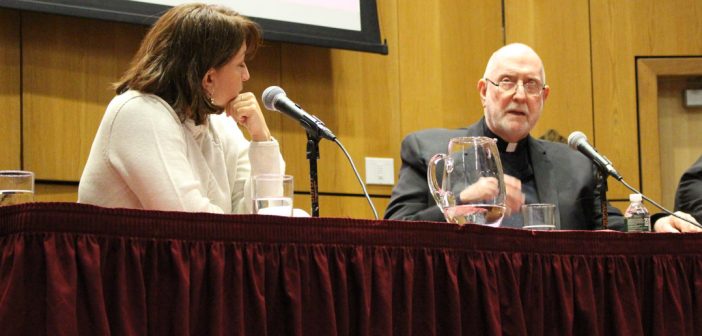“In so little room as the state of Israel and the Palestinian territories, there is entirely too much hatred,” said Patrick J. Ryan, S.J., Laurence J. McGinley Professor of Religion and Society. “Notice that I call all three of these territories the Holy Land. We must keep in mind that all three of these territorial divisions are holy for Jews, holy for Christians, and holy for Muslims, but holy for each faith community in a different way.”
The history of religious ties to the area and how they impact the present-day conflicts were the central themes of the fall McGinley lecture titled, “Faith and Conflict in the Holy Land: Peacemaking Among Jews, Christians and Muslims.”
The lecture and panel discussion, which took place on Nov. 12 and Nov. 13 at the Lincoln Center and Rose Hill campuses, respectively, featured a keynote speech from Father Ryan followed by two respondents—Ebru Turan, Ph.D., history professor at Fordham, and Abraham Unger, Ph.D., GSAS ’92, ’07, campus rabbi and associate professor of government and politics at Wagner College.
‘Perpetual Migrants’
Father Ryan highlighted in his lecture that “nobody comes from nowhere” and that “all of us are both native and immigrant.”
Unger, who delivered the Jewish response, emphasized the fact that Jewish people, in particular, have been considered “perpetual migrants” and that this view of their history needs to be taken into account when thinking about present-day Israel and Palestine.
“I suggest the conflict reaches into the existential nature of the Jewish people itself, both for Jews and for the rest of the world when thinking about Jews,” Unger said.
The Jewish identity, according to Unger, has always included a sense of being a “marginalized outsider” or watching for the next wave of oppression. That’s why the desire for a homeland is so essential, he said.
If the conflict is looked at under that lens, Unger said, it can be seen as bigger than simply “how much area Jews and Arabs ought to respectively get out of the Holy Land.”

Patrick J. Ryan, S.J., Laurence J. McGinley Professor of Religion and Society (center) and respondents Ebru Turan, Ph.D., history professor at Fordham, and Rabbi Abraham Unger, Ph.D., GSAS ’92, ’07, associate professor of government and politics at Wagner College, discuss the Holy Land at the fall McGinley lecture.
Sacred Sites of Significance
For Christians, the Holy Land is not “a major theme in Christian scriptural sources,” Father Ryan said, although Christians as early as the second century took an interest in the area, and that interest grew following the reign of Constantine.
“To Constantine we owe the location of the place in Jerusalem where Jesus died, was buried, and rose again—now the Church of the Holy Sepulcher,” Ryan said, noting that the Roman emperor commissioned the church. “Helena [Constantine’s mother] is said to have built the original Basilica of the Nativity in Bethlehem and an oratory on the Mount of Olives, marking the locale where the disciples witnessed the ascension of Jesus.”
In the Islamic tradition, the “sanctity of the Holy Land in Islam is concentrated in one particular spot in Jerusalem called the Noble Sanctuary,” said Turan, who delivered the Islamic response.
“The Noble Sanctuary houses two of the most sanctified and majestic monuments of Islam—the Dome of the Rock and the Aqsa Mosque,” she said, identified by Islamic authorities as the site of the Prophet Mohammad’s night journey and heavenly ascension.
Present-Day Challenges
Understanding these diverse religious ties to the Holy Land can help people better understand the ongoing conflict in the Middle East, according to the speakers. Still, they said there were no easy solutions.
“How can we have a safe Israel within its borders? On the other hand, how can we have a sovereign Palestine state with its own government and arms—these two are not compatible.” Turan said, stating that she still wished for peace. “That’s why it is not that easy, because the space is very, very tight.”
Unger highlighted another challenge: The area has seen its Christian population, which had oftentimes eased tensions between the Jewish and Muslim populations, decrease rapidly.
“There’s a tremendous Palestinian-Christian diaspora emerging,” he said. “This is a great loss for the majority Jewish population because the Christian-Arab population sometimes has been and also can be a bridge between the Muslim majority within the Arab sector…as well as a bridge to the West itself and to the Jewish majority.”
A Dream of Peace
Father Ryan, however, encouraged the next generation to look to history and then try to find a way forward.
“I have shared with you this evening my dream—an old man’s dream—in the hope that some young people here will see visions, visions of peacemaking in the Holy Land, peacemaking in every land,” Father Ryan said.



